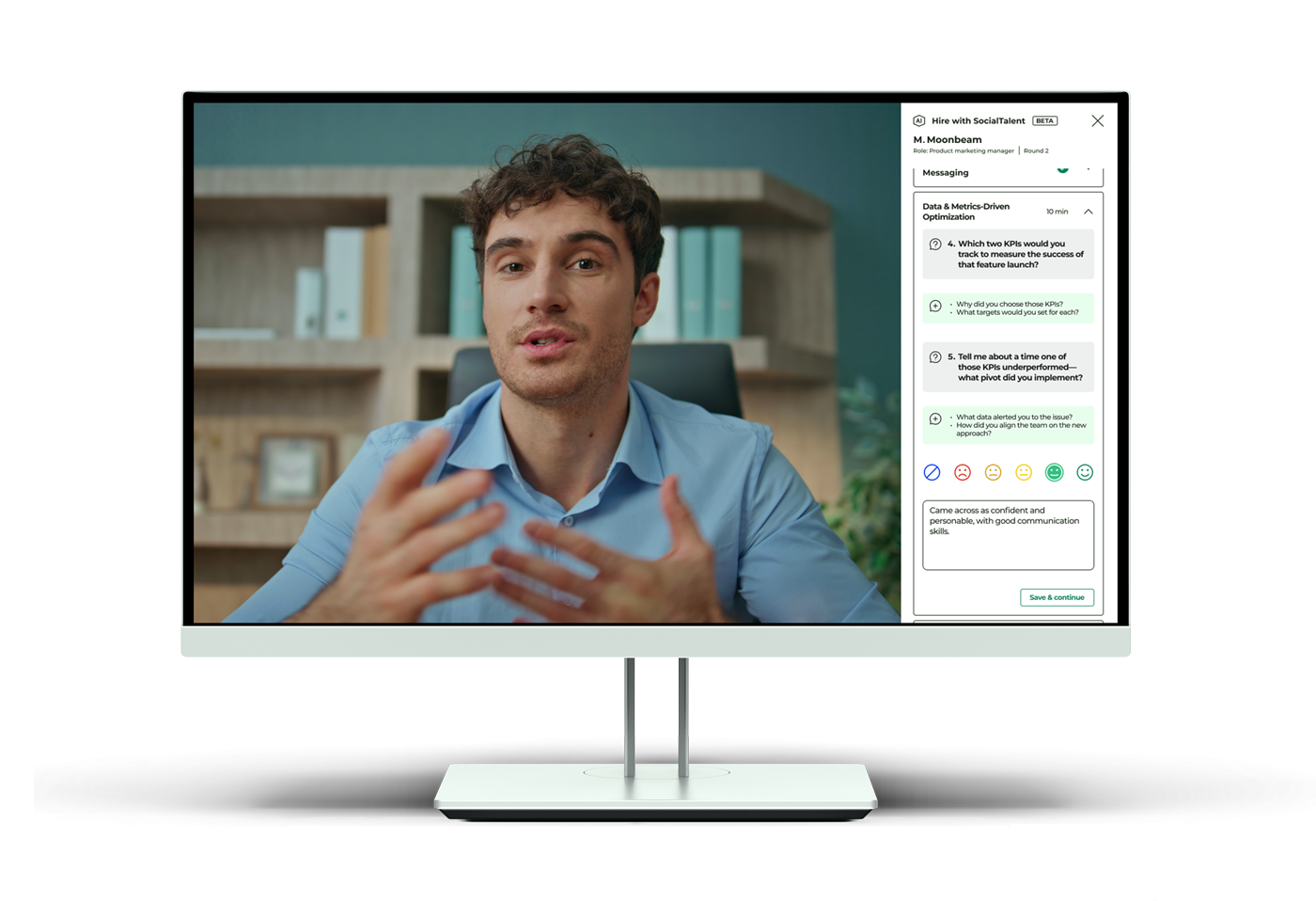
By Johnny Campbell
✨ AI Summary:
- Master Talent Advisor 1.0 fundamentals by consistently advising on hiring strategy with data before moving to the expanded Talent Advisor 2.0 remit.
- Shift measurement from generic satisfaction surveys to tracking specific Talent Advisor behaviors around market insights, sourcing strategies, and role redesign recommendations.
- Adopt AI tools to relieve administrative workload, enabling recruiters to build capacity for strategic talent advising and continuous skills development.
- Invest in cross-domain training—organizational design, workforce planning, and automation analysis—to equip TA teams to advise on whether and how to hire or restructure roles.
Last week in London, we hosted a Supper Club with 20 executive-level TA leaders from across Europe. Different industries, different company sizes, different markets. But they all came with variations of the same question:
“How do we actually become the talent advisors our business needs us to be?”
Most organizations are asking their TA teams to be “talent advisors” without realizing that the definition of that role just fundamentally changed. And most TA leaders don’t yet understand what Talent Advisor 2.0 actually requires – or why they can’t get there without solving the capacity problem first.
Talent Advisor 1.0: The 20-Year-Old Concept We’re Still Trying to Master
Let’s start with what “talent advisor” has traditionally meant. This isn’t new – John Vlastelica, The Conference Board and others have been talking about this concept for the best part of two decades.
Talent Advisor 1.0 is about showing up as a strategic partner on hiring: bringing market insights, recommending sourcing strategies, designing effective interview processes, and influencing hiring decisions.
This is the consultant model. Instead of being an order-taker who posts jobs and sources candidates, you’re advising the business on HOW to hire for each role.
The reality? Most TA teams still haven’t mastered this. Many recruiters are still operating as coordinators rather than advisors.
Talent Advisor 2.0: The Expanded Remit That Changes Everything
But organizations aren’t waiting for you to catch up to 1.0. They’re already moving to 2.0.
Talent Advisor 2.0 asks a fundamentally different question: Should we even hire for this role?
This is the classic “Build, Buy, Borrow, Bots” framework coming to life. Instead of just advising on HOW to hire (the “Buy” option), you’re now expected to advise across all talent strategies:
- Whether to hire at all, or redesign the org instead
- Contractor vs. FTE vs. temp vs. outsourced provider
- Internal mobility – can we move or retrain someone we already have?
- Role decomposition – breaking down the job into tasks and determining what can be automated
- Task analysis – with all this AI investment, which tasks should still be done by humans?
This is happening right now. Several companies in that London room have implemented processes where EVERY new hire or replacement goes through a vetting analysis: Is this still the right role? Can tasks be automated? Is there enough meaningful work left after AI does its part for this to be a full time role?
Some TA teams are being asked to lead this analysis. Others are watching Talent Development or other parts of HR own it. Either way, the expectations have expanded far beyond traditional recruiting.
Why This Requires More Than Recruiting Skills
Advising on role redesign, organizational structure, automation analysis, and workforce planning requires knowledge that traditional TA simply doesn’t have.
You need to understand organizational design, talent development, workforce planning and analytics, and business operations. This isn’t “nice to have” anymore. If you’re going to advise a hiring manager that they shouldn’t hire but should instead restructure their team and automate three of the five tasks in the role description, you better know what you’re talking about.
The Cliff Face: Expand or Shrink
Why is this happening now? Two forces are colliding:
1. HR teams are shrinking. That’s just a fact across most organizations.
2. HRBP ratios are getting stretched. We’re seeing organizations double the number of employees per HRBP, which means HRBPs are drowning in reactive work and can’t do proactive talent strategy.
This creates a void. Hiring managers and leaders need strategic talent support and they’re not getting enough of it from over-stretched HRBPs anymore.
Smart TA leaders are recognizing this opportunity and stepping in to fill that void. The challenge? If recruiting doesn’t expand its remit, recruiting shrinks.
You have three options:
- Downsize your team and accept a smaller scope
- Stay in your lane and watch your budget and headcount erode
- Take on more strategic responsibilities and prove your value to the business
Option 3 requires expanding capabilities. But you can’t expand capabilities without first solving the capacity problem.
The Capacity Trap (And Why AI Adoption Matters)
Credit to Kevin Blair for this insight: Stop saying “productivity.” Start saying “capacity.”
When you tell the business you want to improve recruiter productivity, they hear: “We want longer lunch breaks and to go home early.” That doesn’t fly.
When you talk about improving capacity, they hear: “If we’re filling 50 reqs now, we can fill 70 – or we can fill 50 and take on strategic work you’re not getting from anyone else.”
This is why you need AI adoption in recruiting.
You can’t become a Talent Advisor 2.0 if you’re drowning in administrative work, scheduling interviews, chasing hiring managers for feedback, and manually sourcing candidates. You need AI to give you back time so you can invest in learning new domains and providing more strategic value.
This is why AI adoption and talent advisor skills development are intertwined. They’re not separate initiatives – they’re two parts of the same transformation.
The Skills Roadmap
If you’re serious about evolving your team to Talent Advisor 2.0, this is what it takes:
Step 1: Shore up your Talent Advisor 1.0 fundamentals
You can’t skip to 2.0 if you haven’t mastered 1.0. Get 70-80% of your team consistently performing at the consultant level – bringing data, advising on strategy, influencing decisions – before you push to 2.0.
Step 2: Change how you measure success
Stop using generic “hiring manager satisfaction” surveys. Start measuring specific Talent Advisor behaviors: Did the recruiter bring market data? Did they recommend a sourcing strategy? Did they agree on a structured process? These accountability checks are how you objectively measure alignment and shore up daily processes quickly.
When you’re at 80% success on these measures, evolve the questions to measure 2.0 behaviors: Did they recommend alternatives to hiring? Did they help with task analysis and automation recommendations?
Step 3: Invest in AI adoption for capacity gains
Your team can’t learn new strategic skills if they’re buried in administrative work. Deploy AI for candidate sourcing, interview scheduling, interview intelligence, communications, and reporting. Measure the time savings and redirect it to strategic skill development.
Step 4: Build skills beyond recruiting
Provide training in business acumen, organizational design principles, workforce planning and analytics, and learning and development fundamentals. Budget for it. Create learning paths. Give people time to develop.
Step 5: Structure your team strategically
Not everyone needs to be at the same level. Build a model where leaders go deep on strategic domains, senior recruiters can consult on 2.0 topics with support, and recruiters execute with strategic context. Accept that 20-30% of your team may not make this transition.
Evolve or Become Irrelevant
The Talent Advisor 2.0 shift isn’t optional. Organizations are already asking these questions – whether to hire, how to redesign roles, where to deploy automation.
The only question is whether your TA team will be the ones providing those answers, or whether other parts of HR (or consulting firms) will own this strategic work while recruiting gets reduced to pure execution.
Getting there requires:
- Honest assessment of where your team actually is (most aren’t even solid at 1.0 yet)
- AI adoption to create capacity for skill development
- Investment in learning beyond traditional recruiting
- Strategic team design that doesn’t expect everyone to be at the same level
- Metrics that prove your strategic value to the business
It’s not easy. But it’s necessary if you want your TA function to not just survive but to become genuinely indispensable to your organization.
Where is your team on this journey? Connect with me on LinkedIn and let me know!
Want more content like this? Check out SocialTalent.com today!



